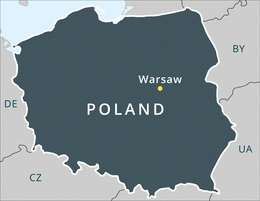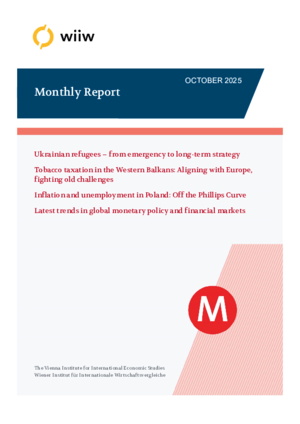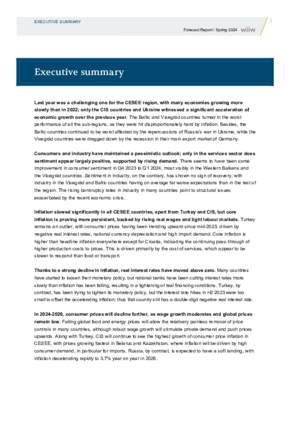Poland
Poland’s economy has been growing steadily in 2025, with GDP expected to rise by 3.5%, driven by household and government spending, as well as by firms replenishing their inventories. However, private investment and exports remain weak, and unemployment is slowly rising, especially in export-oriented sectors. Inflation has eased, but real wage growth is slowing as well, which may reduce consumer demand in the coming years. In the context of a high policy rate and growing private savings, fiscal policy remains expansionary, pushing public debt higher. Despite current stability, structural change in international competitiveness and political tension between the government and the president pose risks to future growth.
| |
|
|
|
FORECAST* |
| Main Economic Indicators | 2022 | 2023 | 2024 | 2025 | 2026 | 2027 |
| Population, 1000 persons | 36822 | 36687 | 36559 | . | . | . |
| GDP, real change in % | 5.3 | 0.2 | 3.0 | 3.5 | 3.5 | 3.0 |
| GDP per capita (EUR at PPP) | 28150 | 29570 | 31440 | . | . | . |
| Gross industrial production, real change in % | 10.3 | -1.2 | 0.6 | . | . | . |
| Unemployment rate - LFS, in %, average | 2.9 | 2.8 | 2.9 | 3.1 | 3.0 | 2.9 |
| Average gross monthly wages, EUR | 1358 | 1585 | 1895 | . | . | . |
| Consumer prices, % p.a. | 13.2 | 10.9 | 3.7 | 3.8 | 3.0 | 2.5 |
| Fiscal balance in % of GDP | -3.4 | -5.2 | -6.5 | -6.9 | -6.4 | -6.4 |
| Public debt in % of GDP | 48.8 | 49.5 | 55.1 | . | . | . |
| Current account in % of GDP | -2.2 | 1.5 | 0.3 | -0.8 | -0.4 | 0.0 |
| FDI inflow, EUR m | 39258 | 32988 | 18998 | . | . | . |
| Gross external debt in % of GDP | 53.2 | 52.0 | 52.2 | . | . | . |
Basic data are continuously updated.
* Forecasts are changed beginning of January, April, July and November.
See Press Conferences.
publication_icon
Monthly Report No. 10/2025
Kristijan Fidanovski, Biljana Jovanovikj, Nóra Kungl, Leon Podkaminer and Maryna Tverdostup
wiiw Monthly Report No. 10, October 2025
42 pages including 10 Tables, 39 Figures
Details
publication_icon
Executive summary
Olga Pindyuk
in: The Crisis is Over, but its Scarring Effects are Hindering Recovery
wiiw Forecast Report No. Spring 2024, April 2024 , pp. I-VII
Details
Poland’s economy has been growing steadily in 2025, with GDP expected to rise by 3.5%, driven by household and government spending, as well as by firms replenishing their inventories. However, private investment and exports remain weak, and unemployment is slowly rising, especially in export-oriented sectors. Inflation has eased, but real wage growth is slowing as well, which may reduce consumer demand in the coming years. In the context of a high policy rate and growing private savings, fiscal policy remains expansionary, pushing public debt higher. Despite current stability, structural change in international competitiveness and political tension between the government and the president pose risks to future growth.


